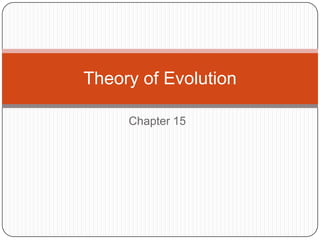
Chapter 15 notes cp
- 1. Chapter 15 Theory of Evolution
- 3. History of Evolutionary Thought Section 1
- 4. The Idea of Evolution In the 1830s, Charles Darwin visited the Galapagos Islands and noted that groups of animals varied on each island Darwin was convinced that organisms had changed over time Proposed the theory of evolution – development of new types of organisms from preexisting types of organisms over time
- 5. Lamarck’s Ideas on Evolution Jean Baptiste Lamarck supported the idea that populations of organisms change over time His idea was the inheritance of acquired characteristics No supporting evidence and has been rejected
- 6. Darwin’s Ideas Darwin published a book – On the Origin of Species by Means of Natural Selection in 1859 proposing a new theory for the way evolution took place Goals of the book: Present the large amount of evidence that evolution occurs Explain the variety and distribution of organisms on Earth in terms of natural selection processes that are observable everyday
- 8. Descent with Modification Darwin reviewed evidence that every species – living or extinct – must have descended by reproduction from preexisting species and that species must be able to change over time First to argue that all species had descended from only one or a few original kinds of life
- 9. Evidence of Descent with Modification Galapagos Islands are home to 13 different species of finches Each has a beak that is best adapted for a certain kind of food Darwin suspected that all descended from one common ancestor The ancestors could have flown from elsewhere after the islands were formed
- 10. Natural Selection Darwin proposed natural selection as the mechanism for descent with modification
- 11. Natural Selection Overproduction More offspring can be produced than can live to maturity Genetic Variation Within a population, individuals have different traits – some can be inherited. Occasionally, new traits may appear in a population.
- 12. Natural Selection Struggle to survive Individuals must compete with each other for resources Some variations increase and individual’s chance to survive and reproduce Adaptation – a trait that makes an individual successful in its environment
- 13. Natural Selection Differential Reproduction Organisms with the best adaptations are most likely to survive and reproduce Through inheritance, the adaptations will become more frequent in a population Populations may begin to differ as they adapt to different environments, even if they descended from the same ancestor
- 16. The Fossil Record Fossil – the remains or traces of an organism that died long ago Among the most powerful evidence of evolution
- 17. The Age of Fossils Relative age – possible to tell a fossil’s age by comparing it to that of other fossils
- 18. The Distribution of Fossils From the fossil record we can infer: Different organisms lived at different times Today’s organisms are different from those of the past Fossils found closer together are more like each other than ones found further away Where and when different organisms existed
- 19. Transitional Species The fossil record shows that species have differed in a gradual sequence of forms over time
- 20. Biogeography Biogeography – the study of the locations of organisms around the world Darwin and Wallace observed species that seemed closely related but were adapted to different environments in nearby regions They also observed animals that seemed unrelated but had similar adaptations to similar environments in regions that were far apart
- 21. Anatomy and Embryology Anatomy – the study of the body structure of organisms Embryology – the study of how organisms develop As generations passed, different populations of descendants adapted to different environments Homologous structures- structures that occur in different species and that originated by heredity from a structure in the most recent common ancestor of the species Analogous structures – closely related functions but do not derive from the same ancestral
- 23. Anatomy and Embryology Vestigial Structures – structures that seem to serve no function but that resemble structures with functional roles in related organisms Development of animal embryos – some stages of vertebrate embryo development are very alike
- 24. Biological Molecules In all species, DNA and RNA are the molecular basis for inheritance of traits Scientists can compare the DNA, RNA, and proteins from many different organisms and look for similarities and differences The greater number of similarities, the more closely the species are related through a common ancestor
- 26. Convergent Evolution Convergent Evolution – the process by which different species evolve similar traits Example: Caribbean Anole Lizards
- 27. Convergent Evolution Many different body types on different islands and different species have the same body types Lizards that live on tree trunks have stocky bodies and long legs Lizards that live on slender twigs have thin bodies, short legs and tails, and large toe pads Lizards that live in the grass are slender and have very long tails How did all of this happen?
- 28. Convergent Evolution Each species evolved independently on each island from different ancestor species
- 29. Divergent Evolution Divergent evolution – Process in which descendants of a single ancestor diversify into species that each fit different parts of the environment Ex: Lizards with genes for large toe pads and short legs ran so slowly on the trunk and ground that predators often caught them
- 30. Artificial Selection Artificial Selection – process when a human breeder chooses individuals that will parent the next generation
- 31. Coevolution Coevolution – when two or more species have evolved adaptations to each other’s influence Ex: Humans develop and use antibiotics to kill bacteria, many populations of bacteria have evolved to resist the effects of antibiotics